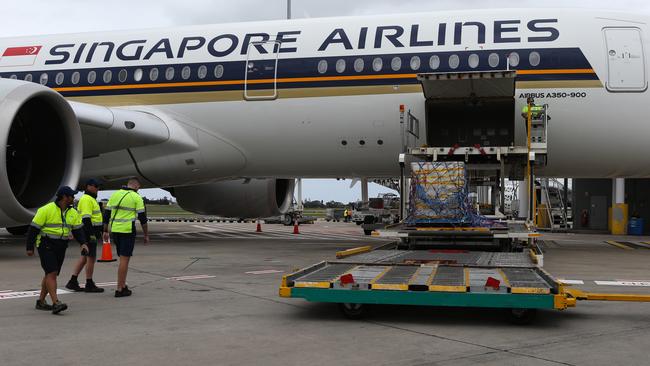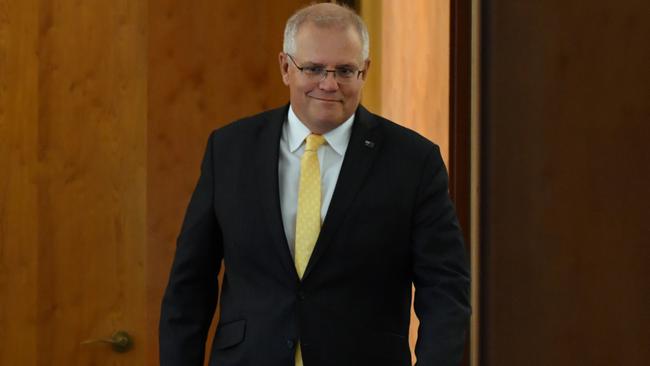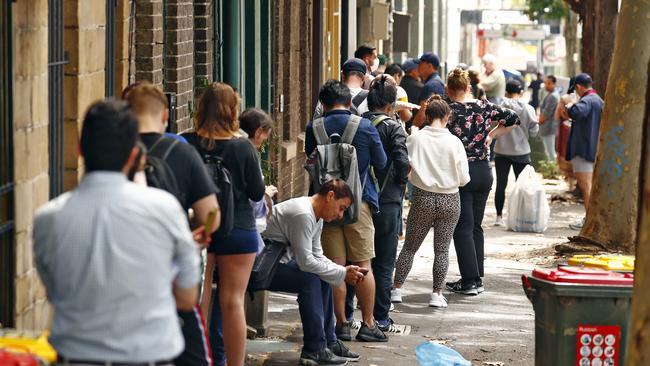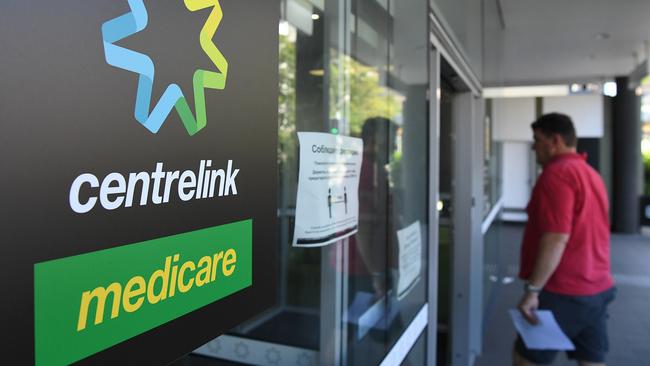Pfizer COVID vaccine arrives, hotel quarantine workers to get first doses
Hundreds of thousands of doses of the COVID-19 have touched down at Sydney airport, with the prime minister revealing when and who will get the first jabs.
NSW
Don't miss out on the headlines from NSW. Followed categories will be added to My News.
In exactly one week a group of Australian quarantine and priority healthcare workers will receive their first dose of the highly effective Pfizer vaccine as the first shipment finally arrives.
More than 142,000 doses of Pfizer vaccine - almost double the amount initially expected - arrived at Sydney Airport shortly after midday on Monday.
The precious cargo has been taken to a secure location, where the vaccine will undergo batch testing and quality assessment.


About 62,000 doses will be kept aside as insurance against unexpected supply chain issues so people are able to receive the second required dose in the correct timeframe.
Of the remaining 80,000, about 50,000 will be distributed evenly among the states on a per head of population basis, where they will start to vaccinate priority quarantine, frontline health, disability and aged care workers.
It is expected the initial fortnight of the rollout will focus on hotel quarantine workers, which have become a major source of risk for COVID-19 outbreaks in the community.
The federal government will retain about 30,000 doses to be distributed to aged care facilities in metro and regional Australia.

Health Minister Greg Hunt announced the historic moment by declaring “the eagle has landed” and confirmed February 22 would be the start date of the rollout.
“In addition to that, the next step will be, we will see AstraZeneca subject
to a decision by the TGA in the near future, and if that is a positive decision that shipping will occur,” he said.
“That should see a doubling of the number of doses per week by early March, if not earlier.”
Australia’s leaders will roll up their sleeves for a “mix” of the available COVID-19 vaccines in Australia to show their faith in the jabs.
Prime Minister Scott Morrison will be given the Pfizer vaccine in the first batch of doses, while Mr Hunt and Health Department Secretary Professor Brendan Murphy will be given the AstraZeneca vaccine, subject to its approval.


Chief Medical Officer Professor Paul Kelly said he was not yet sure which vaccine he would be provided but he would be glad to receive either.
Prof Kelly also confirmed he would review the 72 hour pause on green zone flights form New Zealand after Auckland’s snap lockdown was completed.
“From midnight last night anyone arriving from New Zealand would be treated the same as
any other country of people arriving into Australia, and go into 14 days of hotel quarantine,” he said.
Prof Kelly said he was also watching the situation in Victoria and would later provide an update on the Commonwealth definition of Melbourne as a COVID-19 hotspot.
CITY SLICKERS LAGGING BEHIND COVID RECOVERY
Millions of workers in retail, hospitality, education and construction have come off the JobKeeper subsidy, but Sydney is lagging behind regional NSW in the COVID-19 recovery.
Coffs Harbour, the Southern Highlands, Shoalhaven and the Hunter Valley, excluding Newcastle, had the largest declines in JobKeeper recipients by the end of 2020, according to new data from the Australian Taxation Office.
The figures, which show for the first time how individual regions and industries have recovered since the pandemic was brought under control, indicate Sydney has not bounced back at the same rate, largely due to persistent COVID-19 outbreaks.
Across the state the number of people initially on JobKeeper dropped from 1.2 million by about 60 per cent to 490,000 in December.

In Sydney, the Sutherland Shire has been the slowest to recover, with the number of people on JobKeeper declining just 56 per cent since September.
As of the end of 2020 there were 1.54m people on JobKeeper nationally, down from 3.6m in September 2020.
The number of retail workers on the subsidy dropped by 68 per cent, accommodation and food services were down 52 per cent, wholesale trade down 71 per cent, education and training down 50 per cent and construction down 48 per cent.

Treasurer Josh Frydenberg said there were “encouraging signs” across all sectors that the economic recovery from the COVID-19 pandemic was “well underway”.
“We have more than half a million businesses employing more than two million Australians graduating off JobKeeper,” he said.
“We know that some families and businesses are still doing it tough and my message to those people is that the Morrison Government continues to have your back.”
Mr Frydenberg said there had been more than 785,000 jobs created in the last seven months and the government’s focus was on “getting people back into work”.
“Our Economic Recovery Plan will continue to support the economy through measures such as tax cuts, business incentives, the JobMaker Hiring Credit and a record investment in skills and training,” he said.

Dan Noble, co-owner of Old Mate’s Place bar in the city, praised the JobKeeper payment as the “reason we could reopen”.
His business used the payment until November, when the bar no-longer became eligible as it was making a profit.
“It‘s been really good, we’re super blessed that we’re in the position we’re in right now,” he said.
He said pending any new outbreaks, he agreed with the federal government‘s plan to end the payment at the end of march.
He said “a lot of businesses … looked at it as free money” rather than a ”way to relaunch their businesses”.
Mr Noble believed people who have used the payment are “open and trading and doing quite well”.
NEW ZEALAND ORDERED INTO LOCKDOWN
New Zealand has been re-declared as a red zone for travel with Australia following three cases of community transmission in the nation’s capital.
The change – announced late on Sunday night – will mean anyone arriving from New Zealand for an initial 72 hours from midnight Sunday will be required to complete 14 days of hotel quarantine.
The three day shift reflects the three day lockdown announced by the New Zealand government earlier in the day.

Australia’s Chief Medical Officer Paul Kelly called an emergency meeting of state and territory health chiefs on Sunday to discuss the evolving situation.
“It was decided at this meeting today that all flights originating in New Zealand will be classified as Red Zone flights for an initial period of 72 hours from 12.01am on 15 February,” a federal Department of Health statement read.
“As a result of this, all people arriving on such flights originating within this three-day period will need to go into 14 days of supervised hotel quarantine.”

No flights were due to arrive in Australia from New Zealand on Sunday night.
The ustralian Health Protection Principal Committee will meet again on Monday to discuss any further measures that need to be implemented.
State health teams have been tasked with deciding how to manage anyone who has arrived from New Zealand in recent days.
The National Incident Room has been tasked with helping states access flight manifests.




